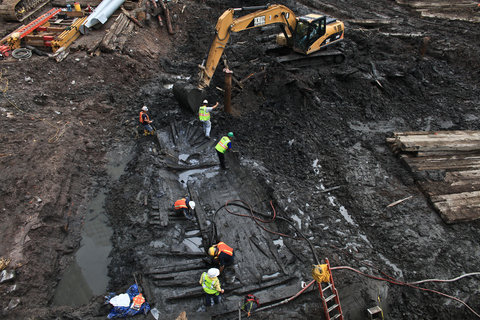 [Image: Photo by Fred R. Conrad, courtesy of The New York Times].
[Image: Photo by Fred R. Conrad, courtesy of The New York Times].
An 18th-century ship has been discovered deep in briny muck “flecked with oyster shells” at the bottom of a World Trade Center construction site. As the New York Times reports, archaeologists called in to investigate the find soon realized that “a wood-hulled vessel had been discovered about 20 to 30 feet below street level on the World Trade Center site, the first such large-scale archaeological find along the Manhattan waterfront since 1982, when an 18th-century cargo ship came to light at 175 Water Street.”
The article adds that “a 1797 map shows that the excavation site is close to where Lindsey’s Wharf and Lake’s Wharf once projected into the Hudson.”

 [Image: Photo by Fred R. Conrad, courtesy of The New York Times].
[Image: Photo by Fred R. Conrad, courtesy of The New York Times].
Recalling the buried ships of San Francisco that we explored several years ago, New York City stands astride landlocked boats, its foundations piled down through wrecks of hulls, grids of masts waiting to be uncovered, perhaps the whole island of Manhattan threatening to unmoor itself one day and set sail into the Atlantic. The prow of Battery Park, ramming through grey waves.
Like some magnificent fulfillment of Lebbeus Woods’s “Slow Manifesto,” all of the island metropolis-at-sea would embody “an architecture that rises from and sinks back into fluidity,” rocking through rogue waves “into the turbulence of a continually changing matrix of conditions, into an eternal, ceaseless flux… drawing its sinews from webbings of shifting forces”, like these buried ships far below, as buildings break down into maritime vessels according to other, more mobile tectonics, the city “struggling to crystallize and become eternal, even as it is broken and scattered” across the oceans of the world.
Manhattan is shaped like a ship, in any case.
 [Image: Photo by Fred R. Conrad, courtesy of The New York Times].
[Image: Photo by Fred R. Conrad, courtesy of The New York Times].
The New York Times adds that these blackened timbers now emerging were clearly “more than just remnants of the wooden cribbing used in the late 18th and early 19th centuries to extend the shoreline of Manhattan Island ever farther into the Hudson River”—a fantastic image of potential structural confusion between the already highly artificial terrain of southern Manhattan (its “land” actually a thick gauze lodged inside “wooden cribbing” and held in place by seawalls and heavy office blocks above) and these strange foreign bodies of wooden ships, their diagonal counter-grids and unexpected stratigraphies piercing the underground matrix like slow bullets. That is, until a newfound archaeological buoyancy brings them up from the briny deep, like rare submarines surfacing through mud and darkness.
Buried ships—flaws in the wooden crystal of the city—interrupting New York’s grounded logic from below.
Read more at the New York Times.
(Thanks to Alan Mitchell and @magicandrew for the tip!)

Eerily similar to some images of the Swiftship excavation from issue #4 of Planetary.
check out the website: http://themannahattaproject.org/
similar to Plimmer's Ark
http://www.museumofwellington.co.nz/inconstant/
Your writing is stunningly beautiful. While walking the streets of Manhattan I often imagine the skyscrapers tunneled below my feet (not just above my head). Now I'll add an imaginary armada of wooden ships. Thank you.